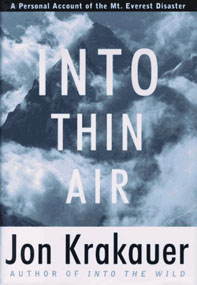Go read Into Thin Air
 For the last little while I have been reading the book “Into Thin Air” by Jon Krakauer, and I suggest you have a read of it. If you want to read about a real-life adventure, or if you want to learn more about climbing in general and high altitude in particular, or some of the history of Mt. Everest, you will find it all there. It’s a good book for everyone, as it assumes you know very little about the world of mountains and climbing them. Many people I have spoken with that have very little interest in mountains and climbing really enjoyed the book; it gives a very good description of what it’s like to climb in these high mountains, things I explain to people when I show them my photos and share my experiences. So if you have a read of this book you will know at least some of what I’m going through when I am on my trip this spring.
For the last little while I have been reading the book “Into Thin Air” by Jon Krakauer, and I suggest you have a read of it. If you want to read about a real-life adventure, or if you want to learn more about climbing in general and high altitude in particular, or some of the history of Mt. Everest, you will find it all there. It’s a good book for everyone, as it assumes you know very little about the world of mountains and climbing them. Many people I have spoken with that have very little interest in mountains and climbing really enjoyed the book; it gives a very good description of what it’s like to climb in these high mountains, things I explain to people when I show them my photos and share my experiences. So if you have a read of this book you will know at least some of what I’m going through when I am on my trip this spring.
I thought it was a very good book, well written and a well told story. It’s not quite as epic as “Touching the Void” by Joe Simpson (read that one after if you want, it’s one of my favourite books ever), but good nonetheless. However, read “Into Thin Air” with a grain of salt, as there is some controversy over some of the things in that book, mainly the author’s guesses at people’s motivations for their actions. An entire book was written to tell the tale of that disaster from another point of view and question some of what Jon wrote, so just keep that in mind.
Let me know if you want to borrow my copy of the book. I will share some quotes to get you interested:
But at times I wondered if I had not come a long way only to find that what I really sought was something I had left behind.
– Quote taken from Hornbein, “Everest, The West Ridgeâ€
Everest has always been a magnet for kooks, publicity seekers, hopeless romantics, and others with a shaky hold on reality.
The fact that a climber has paid a large sum of money to join a guided expedition does not, by itself, mean that he or she is unfit to be on the mountain.
People who don’t climb mountains – the great majority of humankind, that is to say – tend to assume that the sport is a reckless, Dionysian pursuit of ever escalating thrills. … At least in the case of Everest … the ratio of misery to pleasure was greater by an order of magnitude than any other mountain I’d been on; I quickly came to understand that climbing Everest was primarily about enduring pain. And in subjecting ourselves to week after week of toil, tedium, and suffering, it struck me that most of us were probably seeking, above all else, something like a state of grace.
“If client cannot climb Everest without big help from guide,†Boukreev told me, “this client should not be on Everest. Otherwise there can be big problems up high.â€
Mountaineering tends to draw men and women not easily deflected from their goals. By this late stage in the expedition we had all been subjected to levels of misery and peril that would have sent more balanced individuals packing for home long ago. To get this far one had to have an uncommonly obdurate personality.
Unfortunately, the sort of individual who is programmed to ignore personal distress and keep pushing for the top is frequently programmed to disregards signs of grave and imminent danger as well.
Bottled oxygen does not make the top of Everest feel like sea level. … 29,000 feet with gas felt like approximately 26,000 feet without gas.
Not only during the ascent but also during the descent my willpower is dulled. The longer I climb the less important the goal seems to me, the more indifferent I become to myself. My attention has diminished, my memory is weakened. My mental fatigue is now greater than the bodily. It is so pleasant to sit doing nothing – and therefore so dangerous. Death through exhaustion is – like death through freezing – a pleasant one.
– Quote taken from Reinhold Messner, “The Crystal Horizonâ€